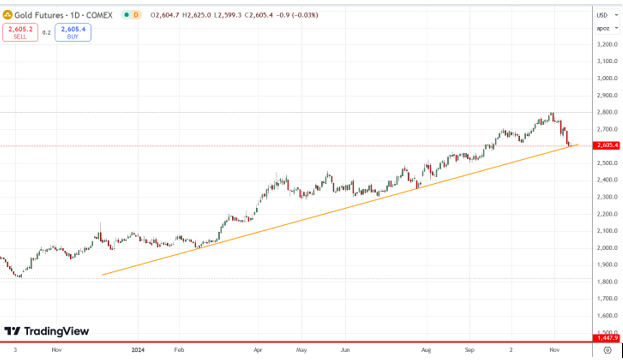Gold prices have found a momentary reprieve, trading just above $2,600 per ounce after a significant sell-off earlier this month. This recovery comes as the precious metal received technical support from a major trendline, halting its short-term downtrend. The recent fluctuations in gold prices are closely tied to the release of the US Consumer Price Index (CPI) data for October, which has implications for future interest rate decisions by the Federal Reserve.
In November, gold experienced a notable decline, hitting seven-week lows primarily due to rising expectations that US interest rates would remain elevated. The latest inflation data revealed that the US headline CPI rose by 2.6% year-over-year in October, up from 2.4% in September, aligning with market expectations. Month-over-month, the CPI increased by 0.2%, consistent with forecasts. Core CPI also remained stable at 3.3%, indicating persistent inflationary pressures.
The Federal Reserve had previously been on a path to potentially lower interest rates due to declining inflation and concerns about a weakening labor market. However, the political landscape shifted dramatically with Donald Trump’s election, leading to fears that his economic policies could potentially reignite inflation and keep interest rates high, factors that typically weigh on gold prices.
Gold’s recent price decline has been exacerbated by significant outflows from Exchange Traded Funds (ETFs). In early November alone, gold ETFs saw net outflows of approximately $809 million (12 tonnes), primarily driven by North American investors. This trend was somewhat mitigated by inflows from Asia, but the overall demand for gold remains under pressure. Additionally, demand from China, the world’s largest consumer of gold, is expected to decline amid an economic slowdown and increasing tariffs imposed by the US on Chinese imports. This combination of factors has created a challenging environment for gold prices.
Another factor contributing to gold’s struggles is competition from alternative investments such as Bitcoin. With Bitcoin trading at all-time highs at over $91,000 and expectations of relaxed regulations under the Trump administration, many investors are diverting funds away from traditional safe-haven assets like gold.
Moreover, US stock markets are experiencing gains as investors anticipate lower corporate taxes and reduced regulations under the new administration. This shift in investor sentiment could further divert capital away from gold.
Geopolitical tensions also play a crucial role in shaping gold’s appeal as a safe-haven asset. The ongoing conflict between Russia and Ukraine remains unresolved, and the new administration’s appointment of Mike Huckabee as Ambassador to Israel raises concerns about escalating tensions in the Middle East, potentially increasing demand for gold if geopolitical risks intensify.
From a technical perspective, gold is currently navigating a precarious position just above its major trendline support around $2,600. Analysts suggest that while there is potential for a short-term rebound, the overall trend remains bearish unless there is a decisive break above recent resistance levels.
 A failure to maintain above this trendline could lead to further declines toward the next support level at $2,540, the 100-day simple moving average and previous highs from August. Conversely, if gold can hold its ground and reverse course, it may align with broader long-term bullish trends.
A failure to maintain above this trendline could lead to further declines toward the next support level at $2,540, the 100-day simple moving average and previous highs from August. Conversely, if gold can hold its ground and reverse course, it may align with broader long-term bullish trends.
As markets absorb the implications of the latest U.S. inflation data and adjust their expectations regarding Federal Reserve policy, gold remains at a critical juncture. Investors will need to monitor both macroeconomic indicators and geopolitical developments closely as they navigate this complex landscape. The interplay between inflation expectations, interest rates, and global demand will ultimately dictate gold’s trajectory in the coming weeks.

